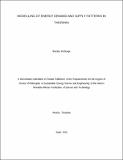| dc.description.abstract | Energy is an important element in realizing the interrelated socio-economic development of countries. In an attempt to develop long term energy demand and supply patterns that would enable the country meet her growing energy demand sustainably using the current and future available energy resources, a study of its own kind was carried out. The analysis of the influential indicators in the determination of energy demand based on the selected socio-economic and environment indicators preceded the study. Artificial neural network-multilayer perceptron (ANN-MLP), multiple linear regression (MLR), and support vector machine for regression (SVR) techniques were employed in the analysis. The findings depicts a strong relationship between energy indicators and energy demand for Tanzania. The energy indicators model showed greater accuracy in the prediction of energy demand as compared to economic and environment indicators models. ANN-MLP, MLR and SVR techniques reached satisfactory prediction results though ANN-MLP produced the most accurate predictions.
The long-term energy demand simulation for a study period 2010-2040 was done using the Model for Analysis of Energy Demand (MAED). The simulation involved case study scenarios to mimic possible future long-term energy demand based on socio-economic and technological development. Simulated results suggest an exponential growth of the total final energy demand with electricity demand shift from household dominance towards industry and service sectors describing changes in the lifestyles. Nevertheless, the electricity demand growth rate has been shown to be greater than that of energy demand describing more mechanisation in the industry and service sectors. Final energy demands per capita shows an increasing tendency while there is a decrease in energy intensity suggesting energy efficient measures.
Long-term energisation plan was achieved through a bottom-up modelling approach using Model for Energy Supply Strategy Alternatives and their General Environmental Impacts (MESSAGE). Least-cost results showed dominance of hydro, coal, geothermal and natural gas as possible supply options for future electricity generation. Though these energy resources are locally available and give least-cost advantages, their combinations is heavily skewed to the non-environmental friendly resources. Optimised results indicate, without interventions in promoting renewable energy, its influence in power generation will remain insignificant and therefore recommends policies
ii
formulations to ensure significant contribution. Finally, the results have established that it is feasible to have a sustainable and economical supply of energy for Tanzania that will meet her energy demand and ensure an optimized option for short, medium and long term energisation plans using currently available energy resources. | en_US |

